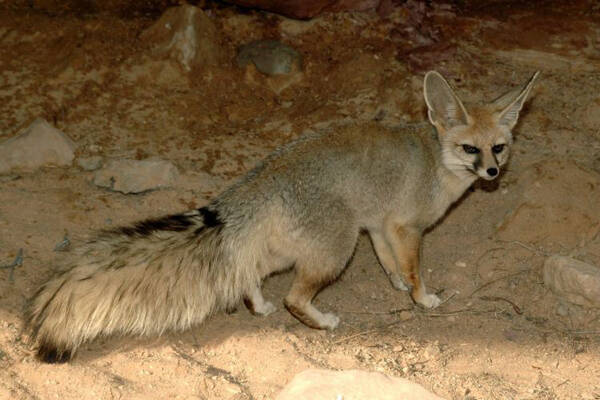Vulpes cana
IUCN
LCBasic Information
Scientific classification
- name:Vulpes cana
- Scientific Name:Vulpes cana,Blanford's Fox
- Outline:Carnivora
- Family:Schizopoda Canidae Vulpes
Vital signs
- length:About 43 cm
- Weight:1.5-3kg
- lifetime:4-10years
Feature
The nose is thin and the ears are large, which can be used to dissipate heat.
Distribution and Habitat
Distributed in Afghanistan, Egypt (Sinai), Islamic Republic of Iran, Israel, Jordan, Oman, Pakistan, Palestine, Saudi Arabia, Turkmenistan, United Arab Emirates, Yemen.
The Afghan fox is very tolerant of high temperatures and usually lives in semi-arid mountainous areas at an altitude of 2,000 meters. Deserts, dune steppes, steppe mountains, mountains, rocky slopes, canyons, cliffs and dry riverbeds are their favorite habitats. This species was historically believed to avoid the hot lowlands and cold highlands. However, it was found near the Dead Sea in Israel, where melons, Russian leeks and seedless grapes are grown.
Appearance
The Afghan fox is a smaller fox. The head and body are 43 cm long, the tail is 30 cm long, the shoulder height is 30 cm, and it weighs about 1.5-3 kg. Males and females are similar in appearance, with males having 3-6% longer forelimbs and body than females. The nose is slender. The ears are large, which can be used to dissipate heat. They have no pads to protect the paws. They have a long, bushy tail that is almost equal to the body length. Their fur lacks the bright colors of the red fox that it lives in the same range, but is just as striking. The coat is soft and luxurious, usually rusty brown or tan, with a gray undercoat and black hair tips, sometimes with spots, lighter on the sides than on the back, and the belly and throat are pale cream to white. A distinct black stripe runs from the middle of the nape to the back, and the tail is usually black, or less white appears. This small fox has a short, pointed muzzle, very large ears, a long, bushy tail, and has a cat-like agility a
Details
Afghan fox (scientific name: Vulpes cana) is also known as Blanford's Fox, and has no subspecies.

Strictly speaking, the Afghan fox is a nocturnal animal and a solitary hunter. Most of the time, the Afghan fox hunts alone. Even mating pairs tend to forage independently. There is no seasonal variation in their activity. They are usually active shortly after dusk and remain active throughout the night. The foraging range averages 1.1 square kilometers, plus or minus 0.7 square kilometers. They are monogamous, with each pair occupying a 1.6 square kilometer territory with little overlap between territories. Like other canids, Afghan foxes have acute vision, smell, and hearing. They communicate through secretion of chemical cues and vocalizations. They rarely cache food. They also seem to drink little water, satisfying their water needs with the food they eat.
Afghan foxes are omnivorous, eating mainly insects and fruits. Prey includes insects such as beetles, locusts, grasshoppers, ants, and termites. They mainly eat two wild fruits of the genus Capparis (Capparis cartilaginea and Capparis spinosa), impatiens, Yemen clover (Ochradenus baccatus), soft Fagonia mollis, and grasses. Fecal samples also have up to 10% vertebrate remains. In Pakistan, they have been recorded eating crops including melons, grapes and Russian olives.
In Israel, Afghan foxes occur at population densities of up to 2 individuals per square kilometer. They are one of the few fox species that regularly climb, scaling cliffs with ease. The exceptionally long tail is used for balance when jumping and climbing.
Afghan foxes breed between December and January. The gestation period is 50-60 days, with a litter size of 1-3 pups. Pups are weaned at 60 days old and reach sexual maturity at 8-12 months old. They live for about 4-5 years, but have been reported as long as 10 years old. Females nurse their pups for 30-45 days. Pups are dependent on their mothers until they can forage for themselves. Young Afghan foxes usually give birth to their pups in a secluded den. The mating system of Afghan foxes is monogamous and the breeding pairs are kept to minimal overlapping ranges, so males may also be considered to provide some care for the offspring, even if it is only in the form of maintaining an area where food is provided. Males have been observed raising pups. The pups remain in their natal range until October or November of the year they are born.
The Afghan fox has a wide distribution range and is not close to the vulnerable and endangered threshold criteria for species survival (distribution area or fluctuation range less than 20,000 square kilometers, habitat quality, population size, distribution area fragmentation), and the population trend is stable, so it is evaluated as a species with no survival crisis. The species is listed on CITES - Appendix II. They are fully protected in Israel and hunting, trapping or trade is not allowed. Breeding requires a special permit from the Israel Nature Conservation Authority. Hunting is prohibited in Jordan and Oman. However, there is no legal protection in Egypt, Saudi Arabia, the United States, Iran, Afghanistan and Pakistan. There are protected areas in Iran, Israel, Jordan, Oman, Saudi Arabia, the United Arab Emirates and Yemen.
Listed in the 2015 Red List of Threatened Species of the World Conservation Union (IUCN) ver 3.1 - Least Concern (LC).
Listed in Appendix II of the Washington Convention on International Trade in Endangered Species of Wild Fauna and Flora (CITES) as a protected animal.
Listed in Appendix II of the 2019 edition of the Convention on International Trade in Endangered Species of Wild Fauna and Flora (CITES).
Protect wild animals and stop eating game.
Maintaining ecological balance is everyone's responsibility!








